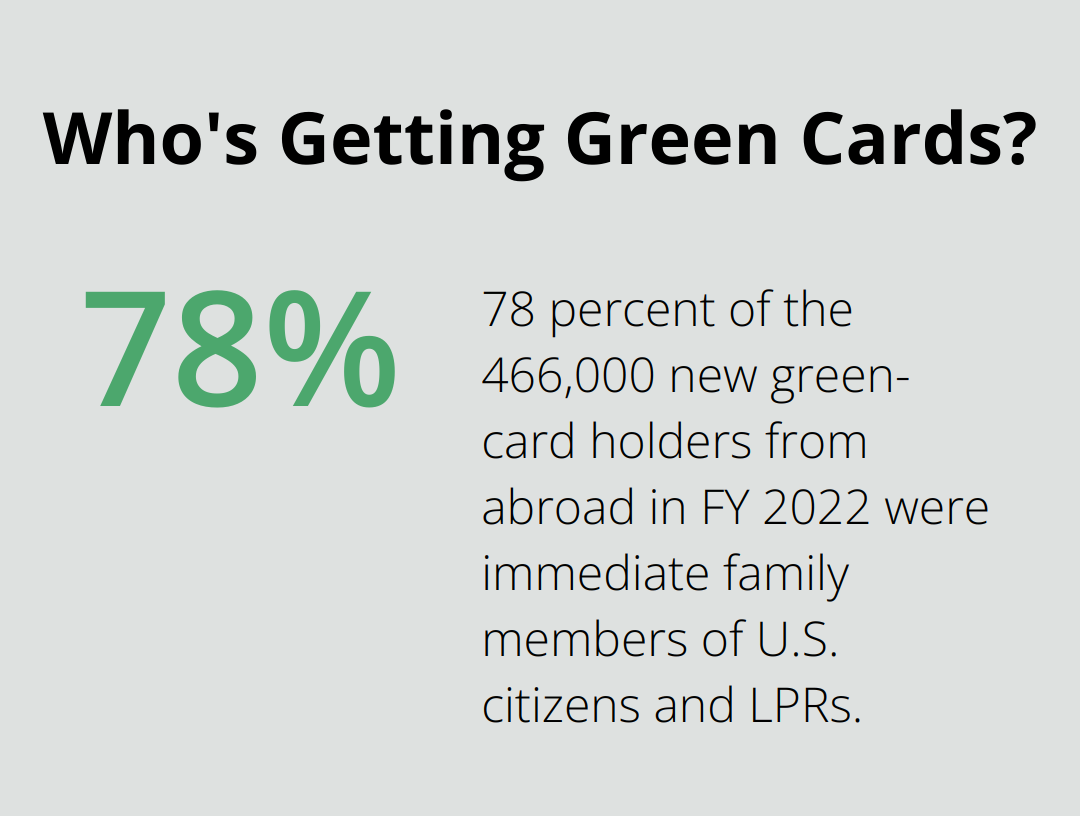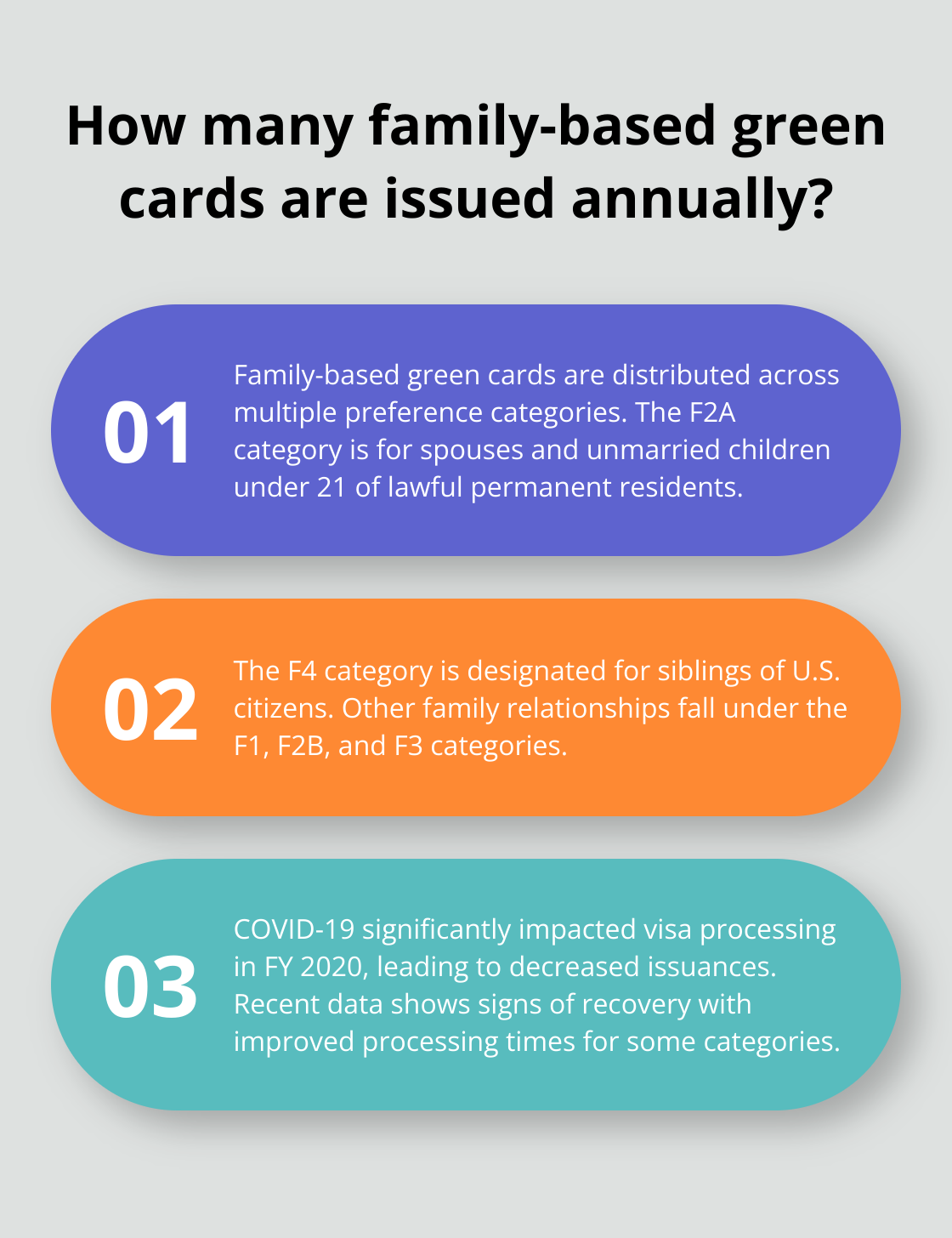
How Many Family-Based Green Cards Are Issued Annually?
Family-based green cards are a cornerstone of U.S. immigration policy, reuniting families and shaping the nation’s demographic landscape. At Law Offices of Jeffrey A. Thompson, we often field questions about the availability of these visas.
Understanding how many family-based green cards are issued each year is crucial for those navigating the immigration process. This post delves into the statistics, trends, and factors influencing family-based green card issuance in the United States.
What Are Family-Based Green Cards?
Definition and Categories
Family-based green cards form a cornerstone of U.S. immigration policy. These visas allow U.S. citizens and lawful permanent residents (LPRs) to sponsor certain family members for permanent residency. The U.S. government divides these green cards into two main categories: immediate relative visas and family preference visas.
Immediate Relative Visas
Immediate relative visas apply to spouses, unmarried children under 21, and parents of U.S. citizens. These visas stand out because they have no annual numerical limits, which makes them the quickest path to obtaining a green card.
Family Preference Visas
Family preference visas fall under annual caps and include four distinct categories:
- F1: Unmarried adult children of U.S. citizens
- F2A: Spouses and unmarried children under 21 of lawful permanent residents
- F2B: Unmarried adult children of lawful permanent residents
- F3: Married children of U.S. citizens
- F4: Siblings of U.S. citizens

The U.S. government allocates visas annually for these family preference categories. However, high demand and annual caps often result in substantial waiting times for certain categories and countries of origin.
Significance in U.S. Immigration
Family-based immigration plays a pivotal role in shaping the demographic landscape of the United States. According to the Migration Policy Institute, of the 466,000 new green-card holders from abroad in FY 2022, 78 percent were immediate family members of U.S. citizens and LPRs. This statistic underscores the importance of family reunification in U.S. immigration policy.
The complexities of the family-based green card process often necessitate expert guidance. Immigration attorneys can provide invaluable assistance in navigating the often lengthy and complex immigration system, potentially increasing the chances of a successful application.
As we move forward, it’s important to examine the specific numbers and trends in family-based green card issuance. The next section will provide a detailed breakdown of annual statistics, offering a clearer picture of the current state of family-based immigration in the United States.
Family-Based Green Card Statistics: A Comprehensive Overview
Annual Issuance Numbers
The United States immigration system issues a substantial number of family-based green cards each year. The United States Citizenship and Immigration Services (USCIS) provides data on various aspects of their operations, including family-sponsored immigrant visas. These reports offer insights into the number of visas approved and the USCIS offices responsible for adjudication.
Preference Category Breakdown
The distribution of family-based green cards varies across preference categories:
- F2A Category: For spouses and unmarried children under 21 of lawful permanent residents
- F4 Category: For siblings of U.S. citizens
- F1, F2B, and F3 Categories: For other family relationships

These numbers represent visa availability, not actual issuances. The actual number of green cards issued in each category can be lower due to processing delays, backlogs, and other factors.
Recent Trends and Challenges
Family-based immigration has faced several challenges in recent years:
- COVID-19 Impact: The pandemic disrupted visa processing, leading to increased backlogs and longer wait times. FY 2020 saw a notable decrease in family-based green card issuances due to pandemic-related restrictions and office closures.
- Signs of Recovery: Recent data shows improvement. The Department of State’s visa bulletin indicates forward movement in priority dates for some family preference categories, suggesting improved processing times. (For example, the F2A category has become current for most countries, allowing for quicker application processing.)
- Persistent Backlogs: Despite positive trends, the backlog of pending family-based I-130 petitions remained substantial, exceeding 1.5 million cases at the end of FY 2023. This backlog continues to pose challenges for many families seeking reunification through the U.S. immigration system.
Understanding these statistics and trends is essential for individuals and families navigating the family-based green card process. The next section will explore the factors that affect these numbers and how they impact the overall landscape of family-based immigration in the United States.
What Shapes Family-Based Green Card Numbers?
Annual Caps and Processing Backlogs
The Immigration Act of 1990 increased the total number of visas available to 675,000 per year, with 480,000 allocated for family-sponsored visas. This number fluctuates based on the previous year’s usage and the number of immediate relative visas issued (which are not subject to numerical limits).

Processing backlogs significantly affect the number of green cards issued annually. As of March 2020, USCIS had 1,858,688 pending Family Green Card applications, almost triple the number received in 2019. This backlog creates a substantial delay between application and issuance, impacting annual statistics.
Country-Specific Limitations
The Immigration Act of 1990 also introduced a per-country cap that restricts green cards allocated to any single country to no more than 7% of annual visas in capped categories. This limitation disproportionately affects applicants from high-demand countries like Mexico, China, India, and the Philippines.
For example, Filipino siblings of adult U.S. citizens who applied for green cards in 2018 faced a wait time of 23 years due to these country-specific caps. This extended wait time not only affects individual families but also impacts the overall number and distribution of family-based green cards issued each year.
Policy Changes and Their Impact
Immigration policies directly affect green card issuance rates. The implementation of the Public Charge Rule in 2019 led to increased denials of Family Green Card applications. USCIS data shows that in 2019, 139,696 Family Green Card petitions and applications were denied (a record number), with the Public Charge Rule as a significant factor.
More recently, efforts to reduce processing times have been implemented. USCIS introduced policies to streamline the processing of family-based green card applications by prioritizing cases pending longer than six months. This initiative, if successful, could increase the number of green cards issued annually.
Economic Factors
Economic conditions in both the United States and applicants’ home countries can influence family-based green card numbers. During economic downturns, there may be changes in immigration patterns or policies that affect the number of applications and approvals.
Global Events and Crises
Major global events, such as pandemics or geopolitical crises, can significantly impact family-based green card issuance. For instance, the COVID-19 pandemic disrupted visa processing, leading to increased backlogs and longer wait times. FY 2020 saw a notable decrease in family-based green card issuances due to pandemic-related restrictions and office closures.
Final Thoughts
Family-based green cards shape the United States’ immigration landscape. Each year, hundreds of thousands of these visas are issued, impacting families seeking reunification. Factors such as preference categories, country-specific limitations, and processing backlogs influence how many family-based green cards are issued annually.

The process presents challenges, including backlogs and policy changes. Recent efforts aim to streamline application processing and reduce wait times. Understanding these statistics and trends helps individuals and families plan effectively for their immigration journey.
Law Offices of Jeffrey A. Thompson specializes in guiding clients through family-based green card applications. Our expertise in immigration law allows us to provide tailored assistance, helping families overcome legal hurdles. We support our clients throughout the process, aiming to turn their dream of family reunification into reality.


